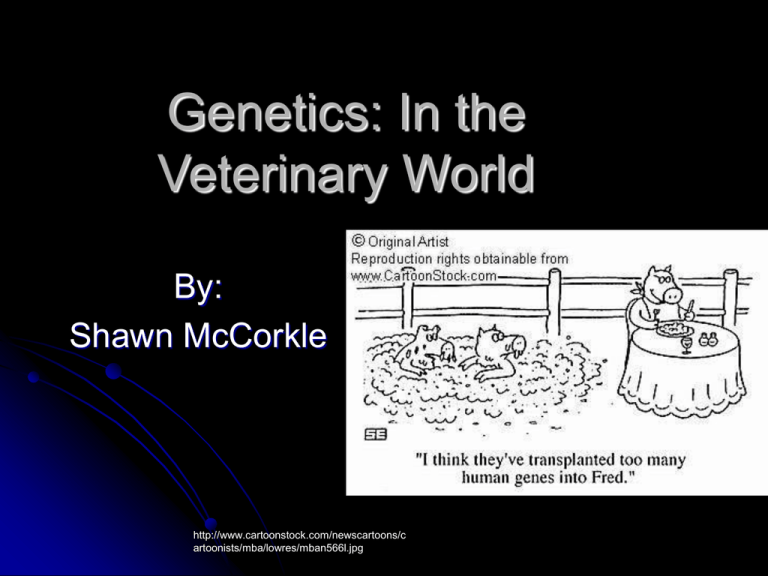Shawn's Genetics
advertisement

Genetics: In the Veterinary World By: Shawn McCorkle http://www.cartoonstock.com/newscartoons/c artoonists/mba/lowres/mban566l.jpg What is genetics? The study of how traits are passed from generation to generation OUTLINE The Basics Dog Breeding Genetic Diversity in Wildlife Review Terms DNA- genetic material that contains the instructions for the development of nearly all living organisms Chromosome-Contains strands of DNA Gene- Piece of DNA, the unit of heredity Review terms cont. Homologous chromosomes-pairs of chromosomes that have similar genetic information. O Allele-one alternative form of a gene Dominant Alleles Recessive Alleles Homozygous = same allele Heterozygous = different alleles O Dominant Alleles Recessive Allele Recessive Allele Is this parent Homozygous or Heterozygous? B b B B B B b B B B B b What about this parent? How do the offspring change? So, How Do Genes Express Themselves? Remember, A gene is a piece of DNA DNA STRAND G C A PROTEIN 3. Proteins carry out functions in the body Review Questions What’s an allele? What does homozygous and heterozygous mean? What is made when a gene expresses itself? How many chromosomes do human cells have? Genetics and Dog Breeding Pure Breed Dog - A recognized strain established by breeding individuals over many generations In-Breeding- breeding between close relatives Inbreeding Recessive disease-carrying allele http://en.wikipedia.org/wiki/Inbreeding_depression Examples of Genetic Disorders Magnified by In-Breeding in Dogs Hip dysplasia Deafness Heart Disease Hip Dysplasia Deafness Heart Disease Review Questions What’s the ultimate negative effect of inbreeding? What are some examples of disorders as a result of in-breeding? What type of dogs are more prone to developing hip dysplasia? Wildlife Genetics Genetic Diversity The total number of genetic characteristic within a species Refers to a population Genetic Diversity • Every individual has a unique set of genes • This genetic diversity within a population is what allows for organisms to adapt to various environmental changes The Cheetah The Cheetah: Small populations and lack of genetic diversity • Past threats: Climate Change – Population decline and subsequent loss of genetic diversity • Current threats: Human induced – Habitat destruction – Hunting (poaching) – Currently 12,00015,000 The Cheetah: Small populations and lack of genetic diversity • Are there now enough cheetahs to sustain a population? • So, how bad is the cheetah’s genetic diversity? -Cheetahs share 99% of the same genes. A normal species shares only 80% Genetics in Real Life Cloning Gene Therapy Stem Cell Research Human Genome Project Disorders caused by mutations: Downs Syndrome Huntingtons Turner Syndrome Klinefelter’s Syndrome THE END THANK YOU!!! Puppy Mills vs Animal Shelters Large scale breeding facilities that operate in bad conditions Can result in: Hereditary defects in puppies A facility that houses homeless, lost or abandoned animals Promotes: “Muts,” which ultimately leads to a more genetically diverse population Wildlife Population What is the #1 problem facing wildlife populations? HABITAT LOSS/FRAGMENTATION -Caused mostly by humans Habitat Fragmentation • Definition – Discontinuities created in organism’s natural habitat. • Can occur naturally or by human influence – Natural Habitat Fragmentation • Typically occurs very slowly and does NOT lead to loss in overall genetic diversity – Man-made Habitat Fragmentation • Typically occurs very rapidly and leads to some degree of loss in genetic diversity Man-Made Fragmentation: England Non-disturbed habitat is shown in black. Since the year 400, the habitat has declined until very little undisturbed habitat remains (1960) GENE EXPRESSION BODY GENE PROTEIN GENETIC MUTATIONS BODY GENE PROTEIN Natural Selection vs. Artificial Selection Natural Selection (“Survival of the Fittest”) -Those who were able to successfully compete for food and shelter were able to reproduce and pass on their genes, while others died Artificial Selection (i.e. Dog breeding) -Breeding an animal to enhance certain characteristics Charles Darwin Homozygous Dominant Heterozygous Homozygous Recessive Heterozygous When DNA is mutated, A different Protein is made, and a different function is carried out G C A DNA STRAND PROTEIN NORMAL: MUTATION: G C C Different Types of Mutations Type of Mutation Substitution Deletion Insertion Inversion Duplication Original Sequence Mutated Sequence ATCGTTAGGC ATCCTTAGGC ATCGTTAGGC ATCGGGC ATCGTTAGGC ATCGTCCATAGGC ATCGTTAGGC ATTTGCAGGC ATCGTTAGGC ATCGTTCGTTAGGC Deletion Mutation SCRAMBLED CODE • Original code: “The cat sat on the mat” • Mutations that have little effect on the meaning: “The cat on the mat” (DELETION) “The kat sat on the mat” (SUBSTITUTION) • Mutations that change the meaning “The hat sat on the mat” (SUBSTITUTION) “The cat the mat” (DELETION) • Mutations that make the message nonsensical “The cat eht no tas mat” (INVERSION) Brooks, Martin. “Get A Grip on Genetics.” East Sussex, England, 1999. Pg 27 Cataracts In-Breeding In breeding over a period of time can lead a higher frequency of weaker recessive alleles Inbreeding Depression- a less healthy and therefore less resilient population Real Life Example ABCB1-1∆ (multidrug sensitivity) A deletion mutation Causes dogs to suffer bad reactions to some dewormers Side effects can develop after a single dose Primarily affects herding breeds of dogs The allele is said to have originated with one British sheepdog in the mid-1800s The Cheetah: Small populations and lack of genetic diversity • 10,000 years ago Climate Change caused the majority of the population to die off • Population – 1900 – 100,000 – 1980 – 2,500 – Today – 12,000-15,000 King Cheetah • First reported in 1927 • Example of recessive trait that arose from a mutation Natural • Occur over very long periods of time – up to millions of years • Allows for organisms to adapt to environmental changes • Usually leads to stable, healthy populations • Main contributor to the appearance of new species • Little loss in genetic diversity Anthropogenic • Habitat is destroyed over a short period of time • Does not allow for organisms to adapt and can lead to species extinction • Forest destruction provides better habitat for disease carriers like mosquitoes and ticks • Leaves poor genetic stock and little opportunity for gene dilution • More likely to cause significant loss of genetic diversity Mixed Breeds vs. Pure Breeds








